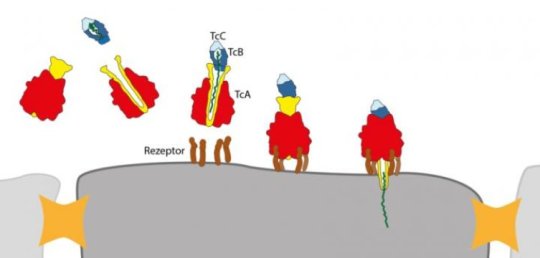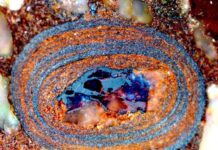[ad_1]
Bacteria have established various strategies to infect organisms and use them as sources of nutrients. Many microbes use toxins that break down membranes by simply piercing through the outer shell of the cells. Human-pathogenic bacteria such as the plague bacterium Yersinia pestis or other bacteria from the salmonella family developed a much more subtle mechanism: they inject their poison by applying a special toxin complex.
A team of researchers led by Stefan Raunser from the Max Planck Institute of Molecular Physiology in Dortmund has now been able to fully unveil the sophisticated mechanism using the bacterium Photorhabdus luminescens as an example.
Bacterial toxins are among the most effective natural poisons. The strongest toxins include e.g. the tetanus and botulinum toxins (botox), already toxic when only a thousandth of a gram is administered. Bacteria have developed highly varied strategies and mechanisms to introduce their poisons into organisms. The bacterium Photorhabdus luminescens, the plague bacterium Yersinia pestis, as well as germs from the salmonella family, use so-called Tc toxins which consist of several components (TcA, TcB, TcC). Until recently, it was unclear how these subunits work together.
In most cases, large bio-molecules such as the complex bacterial toxins cannot be structurally analysed using traditional X-ray crystallography, because they cannot be converted into the required crystalline state. Cryo-electron microscopy, however, does not require the samples to be crystallized. Imaging of even large complexes becomes possible, by freezing them extremely quickly and examining them directly under the microscope at minus 196 degrees. Using cryo-EM the team of Stefan Raunser was able to determine the three-dimensional structure of the Photorhabdus luminescens toxin for the first time in near-atomic detail. The structures showed, that the largest subunit of the poison complex, TcA, resembles a bell, consisting of a channel surrounded by a shell. The upper part of the bell binds the poison capsule formed by the subunits TcB and TcC. Receptors on the cell membrane recognize the lower part of the bell and the loaded poison complex is bound.
Once the pH value of the surrounding medium changes, the outer shell of the toxin opens up, thus revealing the channel. A protein chain kept under high pressure then snaps back and pushes the channel through the cell membrane like the needle of a syringe injecting the poison. The latter is an enzyme which catalyses the clumping of the cytoskeleton, resulting in the death of the cell.
Molecular gatekeeper
Scientists were still missing one last detail to fully understand how the injection of the poison. They needed to find out how this device is controlled. The team from Dortmund achieved this in collaboration with the research group of Manajit Hayer-Hartl from the Max Planck Institute of Biochemistry in Martinsried. The new investigations focused on a small hairpin structure also called the “gatekeeper.” This controls the poison exiting in the direction of the TcA subunit channel — a gateway which resembles a propeller with six blades. When the capsule binds to the channel this border area is restructured: The gatekeeper unscrews itself from the centre of the propeller and reveals the central opening which now precisely connects to the channel of the TcA subunit. The scientists were also able to demonstrate that the presence of the enzyme in the poison capsule is essential for the formation of the whole toxin complex. This points at a possible control mechanism which guarantees that the TcA subunit is charged exclusively with fully loaded poison capsules.
Even today bacterial infections are still among the most frequent causes of diseases with severe progressions (e.g. sepsis). The intensive use of antibiotics has led to the development of fatal resistances which have made it significantly more difficult to win the battle against human-pathogenic bacteria. Uncovering bacterial infection mechanisms will help to better understand the mode of action of human-pathogenic bacteria. The newly obtained insight into the extraordinary mechanism of the Tc-toxin injection could serve as a starting point for developing innovative therapeutic approaches.
Story Source:
Materials provided by Max-Planck-Gesellschaft. Note: Content may be edited for style and length.
[ad_2]















